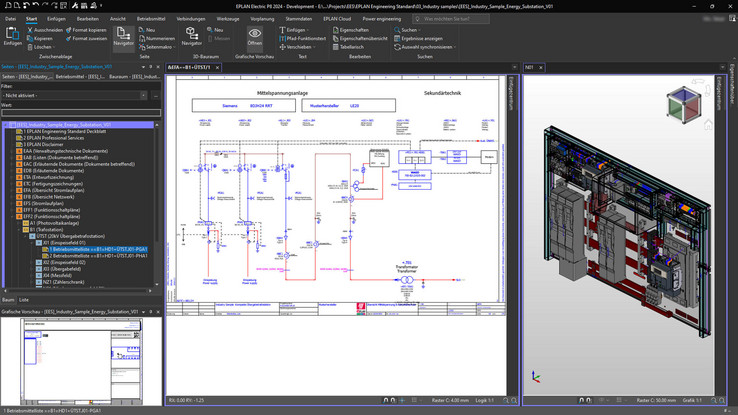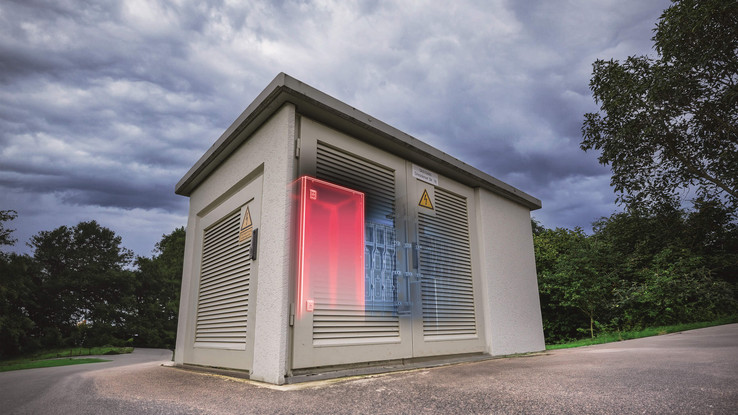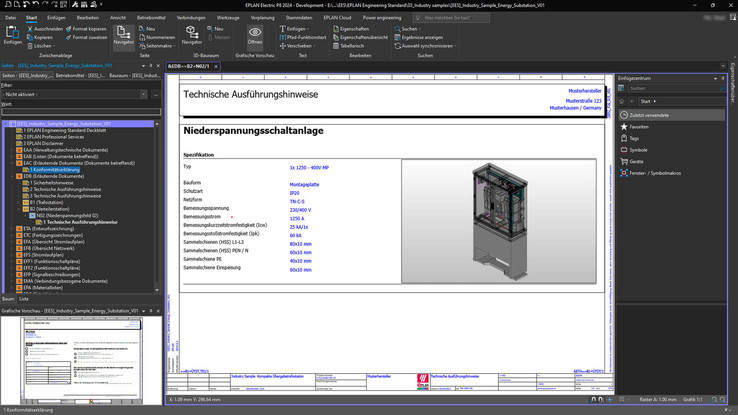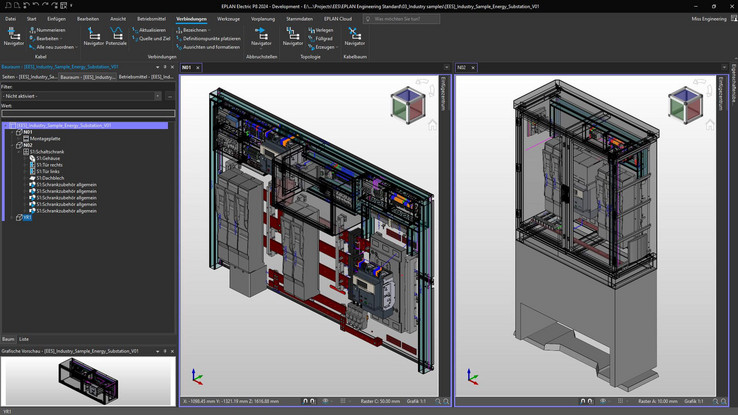Engineering for the Power Grids of the Future
Standardisation and industrialisation from the very start
As we head towards an all-electric society, the current power infrastructure will require massive transformation and expansion. For example, both distribution and transmissions grids will need to be greatly expanded to handle the decentralisation as well as the significantly higher quantities of energy that will be needed in the future. This herculean task can only be accomplished through standardisation, industrialisation and automation. The motto here is “learning from industry” – machine engineering, for instance, has been relying for years on E-CAD platforms that can plan and depict entire projects. These also fulfil one of the central prerequisites for standardisation in production – and for the use of digital twins across the entire service life of a (switchgear) system.
The facts are known and are underpinned by the draft of Germany’s Grid Development Plan 2037/2045, amongst other documents. Transmission and distribution grids will have to be massively expanded to connect the planned increase in renewable energies to the grid and transmit this additional power to consumers. This will require the construction of multiple thousands of new grid stations every year in Germany alone. In addition, there are thousands of stations and substations that must be converted or upgraded. The entire power industry is aiming towards the all-electric society, in which other energy sources – particularly the main fossil fuels such as petrol and diesel (mobility) and natural gas (heating) – will be replaced with electricity. This will tremendously increase the demand for electricity and the power grids will have to become much more flexible. It doesn’t take much imagination to recognise that the amount of expansion and conversion required for local grid stations and transformer stations cannot be achieved with current design and production methods.
Standardisation and industrialisation are the way forward
How can this demand reliably be met in the development and planning phases, as well as in manufacturing and later operations? The answer to this question is inextricably linked to the success of the energy transition. Companies that can resolve these issues have the opportunity to realise considerable growth potential. It’s worth taking a look at industry, particularly machine engineering. Its products – machines – are mainly based on standardised series of products that can nonetheless be customised to specific orders.
Learning from machine engineering – configuration instead of construction
The standardisation of electrical engineering starts during the design and/or project planning phase. The design engineers use either a template project that they modify for each order-related project, or – even better – they work with a schematics configurator, such as EPLAN eBUILD, in which they simply click on functions, characteristics, variants and options. Schematics, bills of materials and other documents are then created automatically.
EPLAN is indispensable in this demanding field of IT-supported and partially automated electrical engineering. This doesn’t just apply to market penetration, but also to the automation of electrical designs. Data consistency both horizontally (across the various steps of project planning, from preplanning with EPLAN Preplanning to commissioning and beyond) and vertically (across individual trades and including suppliers, for instance for cable pre-assembly) offers companies completely new potential for greater data consistency.
In diesem anspruchsvollen Aufgabenfeld des IT-gestützten und teilweise automatisierten Elektro-Engineerings ist EPLAN nicht wegzudenken. Das gilt nicht nur für die Marktdurchdringung, sondern auch für die Automatisierung der Elektrokonstruktion. Die Datendurchgängigkeit sowohl horizontal (über die verschiedenen Stufen der Projektierung, von der Vorplanung mit EPLAN Preplanning bis zur Inbetriebnahme und darüber hinaus) als auch vertikal (über einzelne Gewerke hinweg und unter Einbeziehung der Zulieferer z.B. für die Kabelkonfektionierung) bietet Unternehmen ganz neue Potenziale für mehr Datendurchgängigkeit.
The advantages of standardisation
The use of such a CAE system is ideal for operators of electricity grids and/or decentralised energy systems (for instance charging infrastructure in combination with power storage units or renewable energy sources such as photovoltaics) who are now planning to accelerate their processes via digitalisation and (partial) automation. After all, companies would thereby be laying the foundation for standardisation, which offers numerous advantages for various reasons, as well as for data consistency across the entire engineering and manufacturing process. This also considerably speeds up maintenance and servicing during the later operation of the energy system or substation.
Consistency is everything
First off, operators reap multiple benefits, including the fact that suppliers for the protection and control technology modules can seamlessly continue to work with the documentation from the project planning phase and can add their detail engineering to the existing project. This goes hand in hand with the considerable acceleration and rationalisation of both the design and production of these modules. Operators can take this step without any risk since EPLAN’s standardised and automated electrical engineering is already widely used by many stakeholders in the electricity grid ecosystem. Many suppliers are already using the software and thus intimately familiar with this solution from other industrial projects. The delivery of switchgear systems and transformers, including documentation in EPLAN, is also part of the standard repertoire of many manufacturing companies. Thus data consistency is ultimately ensured throughout the complete documentation for the later operation of the systems.
A common platform for everyone involved in the design process
Another advantage of designing in this way – one that isn’t yet common in the electricity sector – is that everyone involved in the project is always working from the same version of the file. For example, this is true for operators who want to take a look at the current status of the design process (via the Viewing function), for suppliers who require information or for developers who are working from different locations. This makes the planning phase more efficient, increases transparency of all the processes and helps avoid mistakes that occur when participants are working with different versions of a project.
Not just for low voltage
In machine engineering, the EPLAN Platform is used almost exclusively for the planning and design of electrical systems in the low-voltage range. However, this does not mean that the solution is limited to this. In actuality, the software can depict any level of voltage. EPLAN can be used to plan and design entire substations, including those with medium-voltage and high-voltage systems, and there are well-known control-cabinet and switchgear-system manufacturers who have been extensively using EPLAN software for years. Data consistency in planning and production processes is another special feature. Since EPLAN is an affiliate of Rittal, the leading manufacturer of control cabinets and switchgear systems, there is a particularly close connection between the EPLAN software and Rittal’s hardware components (including control cabinets, switchgear systems, power supplies, climate controls, and more).
Example to download: model transformer station project
In line with the principle that nothing is more convincing than a real-world example, EPLAN presented a model project for the energy industry at the SPS trade show in mid-November last year. Working together with clients, a transformer station with medium-voltage and low-voltage systems was developed based on the EPLAN Platform and made available as a project in the EPLAN Cloud. Distribution stations, feed-in stations or mixed systems can be planned based on this standard industrial project, as can energy storage systems for renewable energies. It goes almost without saying that the equipment list specifically required for the energy sector is one of the documents automatically created during the planning process.
Electrical engineering as in machine and plant construction? Give it a try
This project provides those involved in electrical engineering a practical template for planning switchgear systems in the medium-voltage and low-voltage range. It includes traditional functions in the EPLAN software such as single-line and multi-line (single and multi-pole renderings), 3D design for assembly layouts, and analyses (including for terminal diagrams). Uninterruptible power supplies and the feed-in of electricity from photovoltaic systems are also included. The subsequent production is covered, too, since all the data can be transferred directly to manufacturing and used as-is. For good measure, central components such as control cabinets, assembly plates, high-performance distributors for low voltages and the power-distribution components from the Rittal portfolio are already installed or provided for in the template.
Consistent workflows – through to production and beyond
One major advantage of this new planning concept is that the use of the EPLAN Platform doesn’t end with the production and commissioning of the substation. Data from the control cabinets can be downloaded from the EPLAN Data Portal, and processing machines from Rittal Automation Systems can be controlled from the digital twin of the switchgear system. Furthermore, the Rittal ePocket – a digital schematics pocket – always has the current system documentation at the ready. It can be saved, managed and shared in the EPLAN Cloud – and thus forms the foundation for maintenance, servicing or later modernisation of the station.
In conclusion: a new ecosystem for the energy sector
When all the stakeholders use it, the platform creates an ecosystem for the energy sector that can and should be used not just by manufacturers of the grid components and control cabinets, but also, for instance, by system integrators, designers and grid operators. This is how innovative companies in the machine engineering and industrial sectors have been working for years: standardised and automated. Since the requirements for the energy sector are converging with those of the industrial sector – efficient planning and manufacturing of a significantly larger number of standardised systems with a high number of variants – the time has come to take full advantage of the benefits of this approach.






